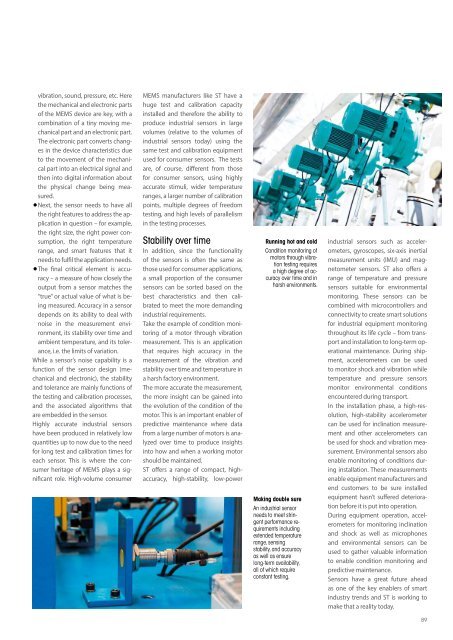Smart Industry 2/2018
Smart Industry 2/2018 - The IoT Business Magazine - powered by Avnet Silica
Smart Industry 2/2018 - The IoT Business Magazine - powered by Avnet Silica
You also want an ePaper? Increase the reach of your titles
YUMPU automatically turns print PDFs into web optimized ePapers that Google loves.
vibration, sound, pressure, etc. Here<br />
the mechanical and electronic parts<br />
of the MEMS device are key, with a<br />
combination of a tiny moving mechanical<br />
part and an electronic part.<br />
The electronic part converts changes<br />
in the device characteristics due<br />
to the movement of the mechanical<br />
part into an electrical signal and<br />
then into digital information about<br />
the physical change being measured.<br />
• Next, the sensor needs to have all<br />
the right features to address the application<br />
in question – for example,<br />
the right size, the right power consumption,<br />
the right temperature<br />
range, and smart features that it<br />
needs to fulfil the application needs.<br />
• The final critical element is accuracy<br />
– a measure of how closely the<br />
output from a sensor matches the<br />
“true” or actual value of what is being<br />
measured. Accuracy in a sensor<br />
depends on its ability to deal with<br />
noise in the measurement environment,<br />
its stability over time and<br />
ambient temperature, and its tolerance,<br />
i.e. the limits of variation.<br />
While a sensor’s noise capability is a<br />
function of the sensor design (mechanical<br />
and electronic), the stability<br />
and tolerance are mainly functions of<br />
the testing and calibration processes,<br />
and the associated algorithms that<br />
are embedded in the sensor.<br />
Highly accurate industrial sensors<br />
have been produced in relatively low<br />
quantities up to now due to the need<br />
for long test and calibration times for<br />
each sensor. This is where the consumer<br />
heritage of MEMS plays a significant<br />
role. High-volume consumer<br />
MEMS manufacturers like ST have a<br />
huge test and calibration capacity<br />
installed and therefore the ability to<br />
produce industrial sensors in large<br />
volumes (relative to the volumes of<br />
industrial sensors today) using the<br />
same test and calibration equipment<br />
used for consumer sensors. The tests<br />
are, of course, different from those<br />
for consumer sensors, using highly<br />
accurate stimuli, wider temperature<br />
ranges, a larger number of calibration<br />
points, multiple degrees of freedom<br />
testing, and high levels of parallelism<br />
in the testing processes.<br />
Stability over time<br />
In addition, since the functionality<br />
of the sensors is often the same as<br />
those used for consumer applications,<br />
a small proportion of the consumer<br />
sensors can be sorted based on the<br />
best characteristics and then calibrated<br />
to meet the more demanding<br />
industrial requirements.<br />
Take the example of condition monitoring<br />
of a motor through vibration<br />
measurement. This is an application<br />
that requires high accuracy in the<br />
measurement of the vibration and<br />
stability over time and temperature in<br />
a harsh factory environment.<br />
The more accurate the measurement,<br />
the more insight can be gained into<br />
the evolution of the condition of the<br />
motor. This is an important enabler of<br />
predictive maintenance where data<br />
from a large number of motors is analyzed<br />
over time to produce insights<br />
into how and when a working motor<br />
should be maintained.<br />
ST offers a range of compact, highaccuracy,<br />
high-stability, low-power<br />
Running hot and cold<br />
Condition monitoring of<br />
motors through vibration<br />
testing requires<br />
a high degree of accuracy<br />
over time and in<br />
harsh environments.<br />
Making double sure<br />
An industrial sensor<br />
needs to meet stringent<br />
performance requirements<br />
including<br />
extended temperature<br />
range, sensing<br />
stability, and accuracy<br />
as well as ensure<br />
long-term availability,<br />
all of which require<br />
constant testing.<br />
industrial sensors such as accelerometers,<br />
gyroscopes, six-axis inertial<br />
measurement units (IMU) and magnetometer<br />
sensors. ST also offers a<br />
range of temperature and pressure<br />
sensors suitable for environmental<br />
monitoring. These sensors can be<br />
combined with microcontrollers and<br />
connectivity to create smart solutions<br />
for industrial equipment monitoring<br />
throughout its life cycle – from transport<br />
and installation to long-term operational<br />
maintenance. During shipment,<br />
accelerometers can be used<br />
to monitor shock and vibration while<br />
temperature and pressure sensors<br />
monitor environmental conditions<br />
encountered during transport.<br />
In the installation phase, a high-resolution,<br />
high-stability accelerometer<br />
can be used for inclination measurement<br />
and other accelerometers can<br />
be used for shock and vibration measurement.<br />
Environmental sensors also<br />
enable monitoring of conditions during<br />
installation. These measurements<br />
enable equipment manufacturers and<br />
end customers to be sure installed<br />
equipment hasn’t suffered deterioration<br />
before it is put into operation.<br />
During equipment operation, accelerometers<br />
for monitoring inclination<br />
and shock as well as microphones<br />
and environmental sensors can be<br />
used to gather valuable information<br />
to enable condition monitoring and<br />
predictive maintenance.<br />
Sensors have a great future ahead<br />
as one of the key enablers of smart<br />
industry trends and ST is working to<br />
make that a reality today.<br />
89
















